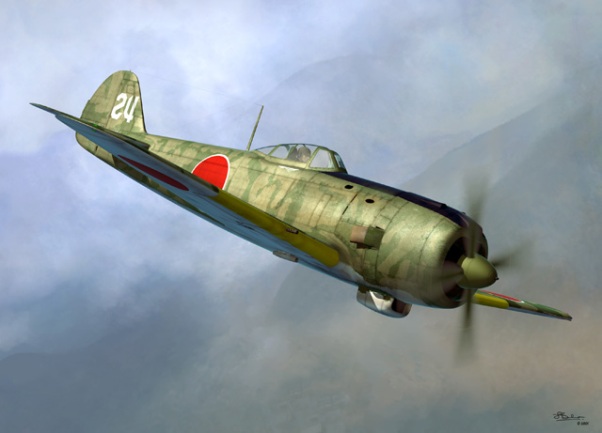
|
 |
Nakajima Ki-84 (Frank) |
 |
 |
 |
 |
 |
|---|---|---|---|---|---|---|---|
 |
 |
 |
 |
 |
|||
 |
||
|
The Nakajima Ki-84, code-named Frank by the Allies or Hayate (Gale) to the Japanese, was the fastest single-engine fighter used by the Imperial Japanese Army Air Force in World War II. It marked the evolution of the series of fighters produced by Nakajima starting with the Ki-27 Nate, and continuing with the Ki-43 Oscar and Ki-44 Tojo. It outperformed the F6F Hellcat, P-51 Mustang and P-47 Thunderbolt. It was a powerful high-altitude fighter that combined the nimbleness of the Ki-43 with the heavy firepower of the Ki-44. It was used to intercept B-29 Superfortresses and was armed with two 12.7 mm machine guns above the cowling and two 20 mm cannons located in the wings. It made its inaugural flight in April 1943 and from the drawing board to the production line was only ten months. Total production was 3,382 aircraft.
1
Requirements were as follows: |
The Ki-84 was designed to replace the Ki-43 Oscar which was just entering service at the time. The new requirement called for an aircraft that would match the performance of any Allied fighter. This called for greater power and maneuverability than the Ki-43 and unlike previous aircraft, such as the famous Mitsubishi Zero, it would have armor protection for the pilot and would be equipped with self-sealing tanks. |
|
The Ki-84 was a cantilever low-wing monoplane with fabric-covered flight controls. It had a slender and graceful looking fuselage which contributed to its aerodynamic performance. The early models were all-metal, but due to the scarcity of precious aluminum, the rear fuselage and other components were constructed of wood with the last three models being constructed of wood entirely. The smooth outside surface of the wooden models was surfaced with a thick coat of lacquer. The cockpit provided very good visibility and the windshield utilized armored glass for pilot protection. As well as protecting the pilot, steel armor was also used to protect the centrally located fuel tank and the methanol-water tanks used for engine emergency war power.
 The Ki-84. It was powered by a 1,800 hp (1,342 kW) fuel injected Homare Ha-45, 18-cylinder radial engine. It was a very powerful engine, very much the equivalent of the 2,000 hp (1,491 kW) Pratt & Whitney R-2800 engine. However, the engine was rushed into production and suffered from fuel starvation which was eventually modified with a low pressure system. Other problems included a faulty hydraulic system and a weak landing gear that would snap during hard landings. Landing gear metal components were brittle due to a shortage of steel alloys and the airplane was plagued with inferior workmanship due to a shortage of skilled workers. The Ki-84 reached a maximum level speed of 387 mph (624 km/h) and in a dive was able to reach a top speed of 496 mph (687 km/h). It had an endurance of 1˝ hours and had a range of 250 miles. It could climb to 5,000 m. (16,405 ft.) in 6 minutes and 26 seconds and had a ceiling of 12,400 m. (40,680 ft.). It was also considered to be a relatively easy plane to fly, reducing time for training new pilots. The first batch of 83 airplanes was completed between August 1943 and March 1944. They were equipped with a centerline fuel tank and external bomb wing-racks to carry a total of 250 kg (551 lb.) of bombs. Service tests were conducted under operational conditions in October 1943. A second batch of 42 aircraft was started in April 1944. The centerline fuel tank was deleted and wing racks could carry either 44 liters of fuel or a total of 250 kg. of bombs. Total production was 3,382 aircraft in only 17 months and continued right up to the end of the war. This was no mean feat since production was constantly being disrupted by continual bombing from B-29 Superfortresses. In late August of 1944, the Ki84 first entered combat over China with the 22nd Air Regiment (this Regiment had been involved in the testing/training period of the new fighter). Initial results were excellent, catching the American Army Air Force pilots completely off guard. While a skilled Ki-84 pilot was evenly matched with the best US pilots and equipment, the majority of Ki-84s lost in the Philippine battles were destroyed on the ground. Overwhelming numbers of US planes controlled the skies and as time went on, the Japanese were soon fighting a losing battle. |
| Specifications: | |
|---|---|
| Nakajima Ki-84-Ia “Hayate” (Frank) | |
| Dimensions: | |
| Wing span: | 36 ft 11 in (11.23 m) |
| Length: | 32 ft 7 in (9.93 m) |
| Height: | 11 ft 1 in (3.38 m) |
| Weights: | |
| Empty: | 5,875 lb (2,665 kg) |
| Loaded: | 7,972 lb (3,616 kg) |
| Performance: | |
| Maximum Speed: | 427 mph (687 km/h) |
| Service Ceiling: | 34,450 ft. (10,500 km) |
| Range: | 1,339 miles (2,155 km) |
| Powerplant: | |
|
One 1,990 hp (1,485 kW) Nakajima Ha-45-21 Homare 18-cylinder radial engine. | |
| Armament: | |
|
Two 12.7 mm Ho-103 machine guns in nose, Two 20 mm Ho-5 cannon in wings, plus two 100 kg (220 lb) or two 250 kg (551 lb) bombs. |
Endnotes:
|
1. Rene J. Francillon, Japanese Aircraft of the Pacific War. Annapolis, Maryland: Naval Institute Press, 1995. 230. |
©Larry Dwyer. The Aviation History Online Museum.
All rights reserved.
Created October 12, 2013. Updated December 9, 2015.